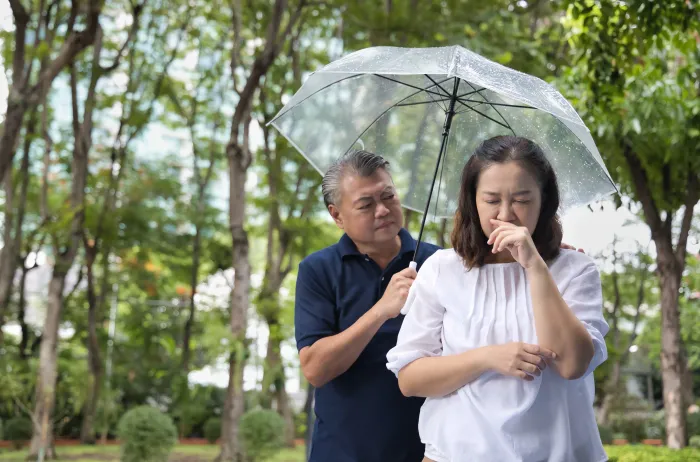Monsoon Allergies: Simple & Proven Ways to Breathe Easier Introduction
Beat monsoon allergies with proven tips: control humidity, stop mould and dust mites, clean air, and the right meds. Learn symptoms, prevention, and relief.

Written by Dr. M L Ezhilarasan
Reviewed by Dr. Rohinipriyanka Pondugula MBBS
Last updated on 28th Nov, 2025

Introduction
When the rains arrive, many people begin to notice sneezing, itchy eyes, and a constantly stuffy or runny nose. Humid weather, damp corners in homes, and spending more time indoors all increase exposure to allergens such as mould spores and dust mites. These microscopic triggers thrive in moisture-rich conditions, making the monsoon a challenging period for anyone prone to allergies. The good news is that with a combination of straightforward home measures, good ventilation, and evidence-based treatment, it is entirely possible to minimise symptoms and stay comfortable throughout the season. Understanding what causes these reactions is the first step towards gaining better control and breathing easier during wet months.Consult a Top General Practitioner for Personalised Advice
What Are Monsoon Allergies?
Monsoon allergies are allergic reactions that flare up during rainy, humid months. They occur because the immune system reacts to harmless airborne particles that become more abundant during the monsoon.
The most common triggers include:
• Mold spores
• Dust mites
• Indoor allergens such as cockroach droppings
• Pollen in some regions
• Pet dander
During the monsoon, mould spores increase significantly as they flourish in damp corners, cupboards, and poorly ventilated areas. Dust mites multiply quickly when humidity rises, making bedding, carpets, and upholstered furniture hotspots for allergic reactions. These triggers can cause allergic rhinitis, conjunctivitis, and worsen asthma symptoms in sensitive individuals. People living in poorly ventilated homes or recently affected by water leaks may notice stronger or more persistent symptoms.
Common Symptoms During Rainy Season
Allergy symptoms can vary from mild irritation to severe discomfort. They often include:
• Sneezing, runny or blocked nose, postnasal drip
• Itchy, watery, or red eyes
• Itchy throat or ears
• Cough, chest tightness, wheezing
• Fatigue and disrupted sleep from nasal congestion
• Skin flare-ups in individuals with eczema
Because allergy symptoms tend to linger, many people struggle to differentiate them from colds or viral infections. Allergies rarely cause fever or intense body aches; if you develop these, it may indicate an infection. Prolonged symptoms, especially those affecting sleep or daily functioning, should be assessed by a healthcare professional for proper diagnosis and management.
Why Monsoon Allergies Get Worse?
Monsoon allergies get worse because of:
• High humidity and dampness encourage mould growth on walls, ceilings, carpets, and stored items.
• Dust mites multiply rapidly when humidity rises above 50 per cent.
• Poor ventilation traps allergens indoors, especially in homes with closed windows during rain.
• Water leaks and flooding cause materials to stay damp long enough to develop mould.
• Some storms can break pollen into smaller particles, increasing their ability to penetrate airways.
Humidity is the key driver of most monsoon-related allergic reactions. Moisture not only nurtures mould but also allows dust mites to survive longer and spread more easily. Combined with limited airflow and prolonged indoor time, allergens circulate more intensely, contributing to worsening symptoms.
How to Prevent Monsoon Allergies at Home?
Simple adjustments to indoor spaces can significantly reduce allergy triggers. The focus should be on ventilation, hygiene, and moisture control.
Control Indoor Humidity (Target 30–50 per cent)
• Use an air conditioner or dehumidifier to keep humidity within the recommended range.
• Run exhaust fans in bathrooms and kitchens during and after use to clear moisture.
• Fix leaks promptly and dry affected areas within 24 to 48 hours.
• Use a hygrometer to track humidity so you can respond quickly to increasing moisture.
Reducing humidity prevents mould from growing and dust mites from thriving. Regular monitoring helps you stay proactive, especially during prolonged periods of rain.
Prevent and Remove Mould Safely
Prevent and remove mould safely by:
• Identify and fix moisture sources, such as leaks or condensation-prone areas.
• Clean small mould patches with detergent and water, ensuring the surface is completely dry.
• If using diluted bleach, follow product instructions carefully and maintain proper ventilation.
• Discard porous items like mouldy carpets or ceiling tiles, as mould often grows deeply within them.
• Seek professional mould remediation for large or persistent outbreaks.
Removing mould at its early stages stops it from spreading through the home. Frequent inspection of damp-prone areas helps prevent major infestations.
Reduce Dust Mites
• Wash bedding weekly in hot water at 55 to 60 degrees Celsius.
• Use allergen-proof covers for pillows and mattresses.
• Keep humidity below 50 per cent to restrict dust mite growth.
• Vacuum carpets, rugs, and upholstery using a HEPA-filter vacuum.
• Reduce soft toys or wash them regularly and store them in sealed bins.
Dust mites thrive in warm, humid environments, which makes the monsoon ideal for their rapid growth. Keeping bedding clean and dry and limiting dust-collecting items reduces daily exposure.
Improve Indoor Air Quality
• Use portable HEPA air purifiers in bedrooms or living spaces.
• Keep windows closed during very humid or stormy weather and open them during drier periods for ventilation.
• Avoid tobacco smoke and incense, which irritate airways and worsen allergies.
• Clean HVAC filters regularly and choose high-efficiency filters if compatible.
Clean indoor air helps reduce respiratory irritation, particularly for those with asthma or chronic sinus issues. A well-maintained ventilation system is essential during damp seasons.
Daily Habits That Help
It includes:
• Perform nasal saline rinsing using sterile or properly treated water to remove allergens.
• Shower and change clothes after returning from outside.
• Dry clothes thoroughly, preferably outdoors when the weather allows.
• Avoid leaving wet towels or clothes piled up indoors.
Small daily routines can significantly reduce allergen exposure. Keeping clothes and household fabrics dry prevents mould from forming during damp days.
When You Go Outside
Follow the tips below:
• Wear a well-fitted mask when gardening or cleaning damp outdoor areas.
• After storms or on humid days, people with asthma or severe allergies may experience heightened symptoms.
• Keep car windows closed during rain and use recirculated air with a clean cabin filter.
Taking preventive steps outdoors can reduce exposure to airborne allergens stirred up by rain or wind.
Evidence-Based Treatment for Monsoon Allergies
For most individuals, combining lifestyle measures with effective medication offers the best symptom control. Options include:
• Antihistamines to reduce sneezing, itching, and a runny nose.
• Intranasal corticosteroids to reduce nasal inflammation and congestion.
• Antihistamine or mast-cell stabiliser eye drops for itchy, watery eyes.
• Short-term decongestants for blocked noses, used cautiously.
• Asthma inhalers as prescribed, especially during flare-ups.
• Allergen immunotherapy for long-term reduction of sensitivity.
These treatments help manage symptoms rather than cure allergies, but they can make the season far more manageable when used consistently and appropriately.
Important safety notes
• Antibiotics do not treat allergies.
• Always use sterile or boiled-and-cooled water for nasal rinsing.
• Seek medical help for breathing trouble, swelling, severe chest tightness, or signs of anaphylaxis.
Who has a Higher Risk During the monsoon?
The higher risk groups include:
• People with asthma, allergic rhinitis, or eczema
• Children who spend time on floors and soft furnishings
• Those living in damp or mould-affected housing
• People recovering from leaks, flooding, or water damage
• Occupations involving damp exposure, such as cleaning or repairs
These groups may require more preventive measures during the rainy season to stay symptom-free.
When to Call a Doctor?
Call a doctor when there is:
• Trouble breathing or chest tightness not relieved by inhalers
• Symptoms lasting beyond two to three weeks
• Fever, thick nasal discharge, or sinus pain
• Eye pain, vision changes, or strong light sensitivity
• Widespread mould growth at home
• Infants, older adults, or those with chronic illness feeling unwell
Prompt medical assessment can help prevent complications or worsening conditions.
Quick Home Checklist for the Rainy Season
Quick home checklist includes:
• Maintain indoor humidity between 30 and 50 per cent.
• Ventilate kitchens and bathrooms; fix leaks quickly.
• Wash bedding weekly in hot water.
• Vacuum thoroughly using HEPA filtration.
• Clean small mould patches safely; discard porous mouldy items.
• Rinse nasal passages with sterile saline; shower after time outdoors.
• Maintain HVAC systems and avoid indoor smoke.
Conclusion
Monsoon allergies can certainly be frustrating, but understanding how moisture and indoor conditions influence symptoms makes it easier to manage them effectively. With a combination of moisture control, regular cleaning, and proper ventilation, the home can become a safer, more comfortable space during rainy months. Evidence-based treatments provide further relief for persistent symptoms and help restore normal daily routines. Paying attention to early warning signs ensures timely intervention and better long-term health. With thoughtful habits and simple adjustments, you can stay healthy and breathe easier throughout the monsoon season.Consult a Top General Practitioner for Personalised Advice
Consult a Top General Practitioner for Personalised Advice

Dr. Anand Ravi
General Physician
2 Years • MBBS
Bengaluru
PRESTIGE SHANTHINIKETAN - SOCIETY CLINIC, Bengaluru

Dr Syed Mateen Pasha
General Physician
2 Years • MBBS
Bengaluru
PRESTIGE SHANTHINIKETAN - SOCIETY CLINIC, Bengaluru

Dr. Syed Ismail Ali
General Practitioner
7 Years • MBBS
Hyderabad
Apollo 24|7 Clinic, Hyderabad

Dr. Johnson. S
General Practitioner
7 Years • MBBS MD(Preventive and social Medicine)
Pune
Apollo Clinic, Nigdi, Pune

Dr. Madhuri Sai Sreepada
General Practitioner
9 Years • MBBS
Hyderabad
BRIGHT SMILES MEDICARE & DENTAL CARE, Hyderabad
Consult a Top General Practitioner for Personalised Advice

Dr. Anand Ravi
General Physician
2 Years • MBBS
Bengaluru
PRESTIGE SHANTHINIKETAN - SOCIETY CLINIC, Bengaluru

Dr Syed Mateen Pasha
General Physician
2 Years • MBBS
Bengaluru
PRESTIGE SHANTHINIKETAN - SOCIETY CLINIC, Bengaluru

Dr. Syed Ismail Ali
General Practitioner
7 Years • MBBS
Hyderabad
Apollo 24|7 Clinic, Hyderabad

Dr. Johnson. S
General Practitioner
7 Years • MBBS MD(Preventive and social Medicine)
Pune
Apollo Clinic, Nigdi, Pune

Dr. Madhuri Sai Sreepada
General Practitioner
9 Years • MBBS
Hyderabad
BRIGHT SMILES MEDICARE & DENTAL CARE, Hyderabad
Frequently Asked Questions
Q1. Are monsoon allergies the same as a cold?
Monsoon allergies are not the same as a cold. Allergies usually cause symptoms such as sneezing, a clear runny nose, and itchy eyes, and they typically do not involve fever. Colds, on the other hand, are caused by viruses and may come with fever, body aches, a sore throat, and thicker mucus. If your symptoms continue for more than two weeks or you develop a high fever, it is best to seek medical advice to rule out infection.
Q2. Do dehumidifiers really help?
Yes, dehumidifiers are genuinely helpful during the monsoon. By keeping indoor humidity below 50 per cent, they create an environment that is far less favourable for mould and dust mites to grow. For best results, the device should be emptied and cleaned regularly, as stagnant water or dirty filters can become sources of moisture or allergens.
Q3. Is it safe to use a neti pot during the monsoon?
Using a neti pot during the monsoon is safe as long as you use sterile water, distilled water, or boiled and cooled water. This is important for preventing infections. The device should be cleaned thoroughly after each use to maintain hygiene. Unboiled tap water should never be used for nasal rinsing, as it may contain microorganisms unsafe for nasal passages.
Q4. Which medicines work best for monsoon allergies?
Many people find significant relief from non-drowsy antihistamines and intranasal corticosteroid sprays, which together help manage sneezing, nasal congestion, and inflammation. Eye drops containing antihistamines or mast-cell stabilisers can soothe itchy or watery eyes. Those with asthma should continue following their prescribed inhaler plan, especially during humid months when symptoms can worsen. If symptoms persist or interfere with daily life, it’s advisable to consult a clinician for personalised treatment.
Q5. Can diet or supplements cure allergies?
Diet or supplements cannot cure allergic rhinitis or allergies related to mould or dust mites. While eating a balanced diet supports overall health and immunity, there is no strong evidence that any supplement can eliminate allergy symptoms. The most effective approach remains reducing exposure to triggers, using evidence-backed medications, and considering allergy immunotherapy if recommended by a specialist.